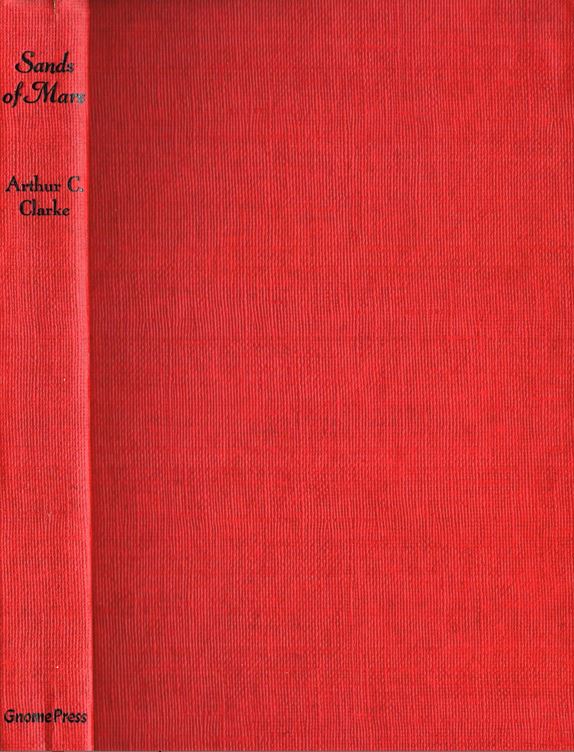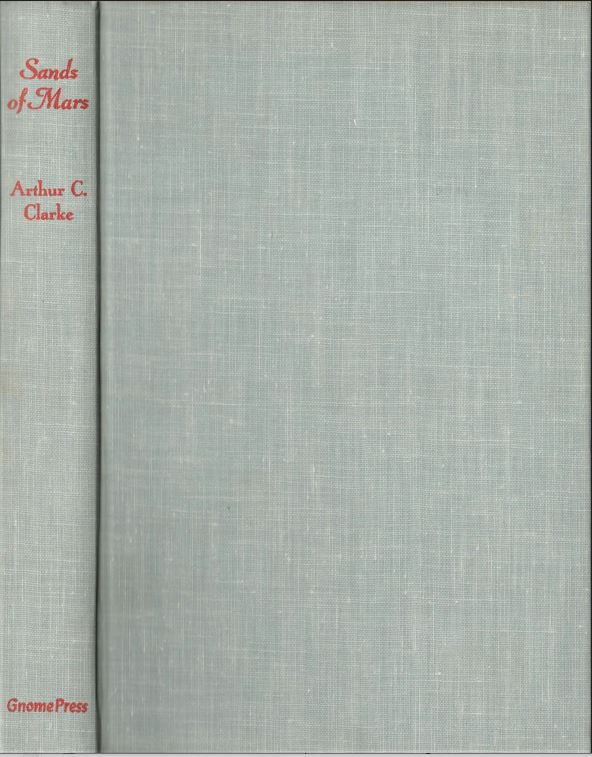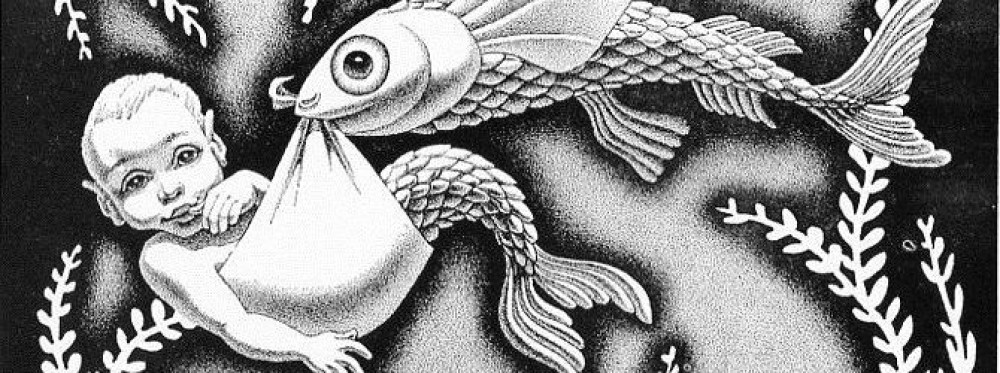Comments
Arthur Charles Clarke (1917-2008) is perhaps the most famous science fiction writer of all time. Those aren’t my words: I’m quoting off my 1990 paperback edition of Clarke’s Astounding Days: A Science Fiction Autobiography. With apologies to Messrs. Wells and Verne, that astonishing statement might even have been true at the time. In 1952, like Lord Byron, Clarke awoke to find himself famous, almost instantly propelled to the pinnacle of public fame.
Although his first two major stories had been published back-to-back in Astounding in April and May 1946, Clarke boasted only a handful of credits before 1952, most of them in second-tier magazines or even fanzines. At best he would be considered a rising young author, but he wasn’t young. Born in 1917, he was two years older than Frederik Pohl, three years older than Isaac Asimov. World War II had interrupted his career and so did a return to college to get his degree. He followed those Astounding stories with an attempt at a novel. As I relate in Prelude to Space, it would be rejected by everybody in the industry until it finally emerged into mostly ignored print in 1951.
A second novel, Sands of Mars, saw publication in England in late 1951. Marty Greenberg snapped it up, his first book to not have had a previous US publication. It appeared in April 1952 to utter silence. The first mention in a newspaper occurs on May 17, in a column merely listing new books at the library. It doesn’t rise to full review status until September. And then, the deluge.
What happened in between? Harper & Brothers, the huge and hugely prestigious publisher, released his non-fiction blockbuster The Exploration of Space in June, which had been hyped for months as the July selection of the Book-of-the-Month Club. The New York Times Book Review gave the book its entire front page, reviewed by Willy Ley and titled “Out of This World By Spaceship.”
Seemingly every other paper in America, as was and still is the norm, followed the Times’ lead. The Exploration of Space was everywhere, often paired with the suddenly discovered Sands of Mars, the convenient fictional interpretation of Clarke’s nonfiction vision. Science fiction was, for the briefest moment, as respectable as the classic poets and painters whose works were also reviewed in that TBR issue. It would not last, but Greenberg, for a change, had a certifiable hit on his hands.
Gnome Notes
Those stories were building Clarke a reputation as the quintessential hard science fiction writer and he was that then-exotic being – a Briton. With Prelude to Space buried as an obscure paperback, the British press treated this novel as a prestigious introduction into fiction for the “chairman of the British Interplanetary Society and a council member of the British Astronomical Association” when the UK firm of Sidgwick & Jackson published it as The Sands of Mars in November 1951.
Gnome left off the definite article and so did the first paperback edition, by Pocket Books in 1954, but seemingly all the later reprint publishers reverted to the original. The copyright page says it is a First Edition, which is legitimate, as Gnome’s is the first American edition and that’s standard for first American editions. The copyright date is given as 1952, the year of American publication.
The Gnome bibliography, however, is a mess and I’m going to make it worse.
The first, 1952, printing was the then-standard 5000 copies. A review slip gives May 15 as the publication date, although Kirkus listed it as April 1. Clarke’s swiftly rising popularity forced Greenberg to print another 3000. ESHBACH and KEMP list two undated printings of 1500 copies each; CHALKER states that 3000 were printed in 1955, with half bound then and half later, in 1957. If ESHBACH is correct, this title is unique in having the only confirmed Gnome 3rd printing. Even if the later output was merely a new binding, that allows for three boards states or three interior states. CURREY doesn’t mention Gnome at all as it wasn’t the true first printing. KEMP has no points for the second printing but writes that the third printing has “37 titles on back of dust jacket. Titling in yellow.” “Titling” seems to refer to the lettering on the boards, but I’ve seen none on any later variant that is yellow. A Science Fiction Book Club (SFBC) variant has yellow lettering, but that could never be confused with a Gnome release.
However, he is correct that a third 37 title variant is known, with titles through mid-1957 on the back panel. The front covers of the original and new jackets are subtly different in concept but obviously distinct when placed side-by-side. Ric Binkley’s dense star field is reduced to a comparatively few dots; the planets gain a dot pattern; the font changes, and Binkley’s name moves from the bottom to the right side, so far right that it disappears around the fold. The flaps also differ. The front flap has indented paragraphs instead of justified type; the rear flap mentions only Clarke’s two other Gnome titles.
The books’ pages are nearly identical, with only one small revision. The tell is on the copyright page. The 1952 original references the by-then expected H. Wolff. The 1957 printing changes that to Noble Offset Printers, Inc. Only five other Gnomes were produced by Noble: the four Judith Merril best of the year anthologies that appeared in late 1956 and June of 1957, 1958, and 1959, and the 1961 reprinting of Gray Lensman. Seeing the Noble name in another 1957 title is odd, but may be tied to the 1957 Merril. Can anyone pretend to believe that taking the plates to different printer five years after publication results in a first edition? Yet that designation is retained. If the copyright page was changing anyway, why not simply make that change as well?
What of the supposed 1955 second printing? I’ve never seen a copy. Nevertheless, I have a copy of a dust jacket with a 32 title back, identical to the one used on Lost Continents, The Forgotten Planet, and the 1954 Foundation second printing. That makes it almost certain that the printing took place in 1954, as the 32 titles list five of the eight books issued in 1954 and none from 1955. The Gnome address remains at 80 East 11th St. in New York rather than the Hicksville address of the 1957 covers. I know of no other copies or even images of the jacket. Why this should be so is yet another Gnome mystery. What boards this variant jacket were once wrapped around are equally unknown. My dust jacket came awkwardly wrapped around a much smaller SFBC edition with black boards. It is inconceivable the SFBC issued the reprint with a Gnome cover. The badly damaged dust jacket may indicate that the Gnome book suffered more severe damage and the owner salvaged what was left.
The black boards SFBC variant is also unique in my experience. Sands has five SFBC boards that I know of: maroon with Sands of Mars horizontally printed, maroon with a broad lime green stripe and Sands of Mars horizontally printed, maroon with Sands of Mars vertically printed, blue with Sands of Mars vertically printed, and black with Sands of Mars vertically printed. The first two are presumably the earlier since their typography exactly matches that of the Gnome original.
Three variants, one of them previously unknown, would seem to be sufficient variety for any one title. Yet the bottomless resources of the Internet keep tossing up unrecorded variants of Gnome titles. Amazingly, not just one but two additional variant boards have been found for Sands: green boards with black lettering and gray cloth with red lettering. Both of them came with the 37-title dust jacket; both of them have the Noble Offset copyright page. They unquestionably came from the 1957 printing, although there is no reason that additional copies couldn’t have been bound at some later time. In fact, evidence suggests this might be true. At least a half dozen Gnome titles have later variant bindings of gray cloth, all lettered in red, from 1959 on. Methuselah’s Children, Tros of Samothrace, and SF: ’59 have later green boards bindings, lettered in black. Methuselah’s has both gray and green. None of these variants changed the dust jacket, so the use of a 1957 back panel is not conclusive proof of that year. Unlike Clarke’s other two Gnome books, Sands would remain on back panels through to the end; continual binding of warehoused copies might have been needed to keep up with demand. New evidence has a dismaying tendency to confound Gnome mysteries rather than solve them.
Review(s)
Noah Gordon, Avon Science Fiction and Fantasy Reader, January 1953
More important than the story itself is the documentary style of the writing. The long journey to Mars is described so convincingly that the reader is tempted to rush out and book passage on the next space-liner. And Clarke’s conception of the red planet is foreign enough to be exotic yet reasonable enough to be thoroughly believable.
Unsigned, Beckley [VW] Post Herald, September 15, 1952
It is soundly, not wildly imaginative, and the reader is certain to be left with a profound impression: this is a story of tomorrow which the author, with complete believability, has brought to life today.
Contents and Original Publication(s)
• Chapters 1-17, London: Sidgwick & Jackson, 1951.
Bibliographic Information
Sands of Mars, by Arthur C. Clarke, 1952, copyright registration 15Apr52, Library of Congress Catalog Card Number not given [retroactively 52-10185], title #21, back panels #20,27,39, 216 pages, $2.75. 5000 copies printed, 1952; 1500 copies printed, 1954; 1500 copies printed, 1957. Hardback. Jacket design by Ric Binkley. “FIRST EDITION” on copyright page.
Variants, priority of 1957 bindings not known
1) Dark red boards, spine lettered in black, printed 1952. Dust jacket, front cover: dense star field, smooth planets, Binkley signature at bottom; rear flap: 18 titles. Manufactured in the U.S.A. by H. Wolff, New York. Back panel: 4 titles; Gnome Press address given as 80 East 11th St., New York 3.
2) [Boards not seen] Printed 1954. Dust jacket: front cover: sparse star field, mottled planets, Binkley signature vertically up right edge; rear flap: Two More Great Books by Arthur C. Clarke. Back panel: 32 titles, Gnome Press address given as 80 East 11th St., New York 3.
3) Dark red boards, spine lettered in black, printed 1957. Dust jacket: front cover: sparse star field, mottled planets, Binkley signature vertically up right edge; rear flap: Two More Great Books by Arthur C. Clarke. Manufactured in the U.S.A. by Noble Offset Printers, Inc. Back panel: 37 titles, Gnome Press address given as P. O. Box 161 Hicksville, N.Y.
4) Gray cloth, spine lettered in red, printed 1957, bound? dust jacket: front cover: sparse star field, mottled planets, Binkley signature vertically up right edge; rear flap: Two More Great Books by Arthur C. Clarke. Manufactured in the U.S.A. by Noble Offset Printers, Inc. Back panel: 37 titles, Gnome Press address given as P. O. Box 161 Hicksville, N.Y. [Not in CHALKER]
5) Green boards, spine lettered in black, Different paper from 1957 bindings, new printing of unknown date? jacket: front cover: sparse star field, mottled planets, Binkley signature vertically up right edge; rear flap: Two More Great Books by Arthur C. Clarke. Manufactured in the U.S.A. by Noble Offset Printers, Inc. Back panel: 37 titles, Gnome Press address given as P. O. Box 161 Hicksville, N.Y. [Not in CHALKER]
True first edition
London: Sidgwick & Jackson, 1951.
Images













